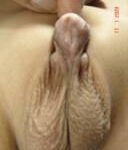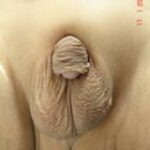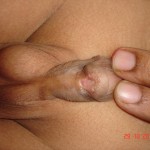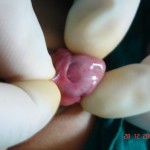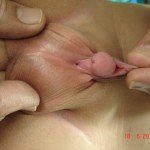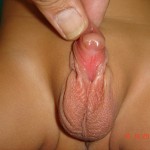INFORMATION AVAILABLE IN ENGLISH, GUJARATI AND HINDI
What is hypospadias and what causes it?
Hypospadias is a birth defect affecting a boy’s penis.
It is a combination of three separate problems:
- The hole through which urine passes (meatus) is not at the tip of the penis
- The foreskin is gathered at the back of the penis with none at the front
- The penis may be bent when stiff.
The position of the meatus varies; in some boys, the hole is only a small distance away from the tip of the penis, whereas in others, it is at the base of the penis, in the scrotum or behind the scrotum.
About one in every 300 boys has hypospadias, although this figure seems to be rising. We do not know what causes hypospadias; more research is needed to learn more about the causes. It is unlikely to have been caused by anything that happened during pregnancy. Hypospadias can be associated with other conditions, such as inguinal hernia or undescended testicles, and your doctor will check your child to confirm or rule out any other problems.
How is hypospadias diagnosed?
Hypospadias is usually diagnosed by clinical evaluation of the appearance of the penis as early as at birth.
Most boys need consultation when a few months’ old, so that treatment can be planned for when the child is about a year old. It is important that circumcision does not take place, as the foreskin is needed during the operation.
How is hypospadias treated?
Although hypospadias does not cause any immediate problems and is not life threatening. If hypospadias is left untreated it may not be possible for the child to pass urine standing up as the urinary stream may go on to wet his trousers or legs. Later on in life, having an adequate erection and having sex may be difficult. The aim of the operation is to straighten the penis, move the meatus to the tip of the penis and to remove the excess foreskin. By doing this, the penis will also look more normal. Usually, it is possible to make these corrections in one operation, but if the hypospadias is severe, correction may be needed in two or three stages in separate operations.
What does the operation involve?
The operation is carried out under an anaesthetic and lasts between one and two hours, depending on the severity of the hypospadias. The skin of the penis is used to create a tube, which extends the length of the urethra so that a new hole can be created at the tip of the penis.
Are there any risks?
There is also a small risk of infection, but your child may be given antibiotics as a precaution.
After an anaesthetic some children may feel sick and vomit. They may have a headache, sore throat or feel dizzy. These side effects are usually short-lived and not severe.
For about one in ten boys, the original hole opens up again, so that your son passes urine through two holes. This can happen at any point after the operation. Small holes or fistula heal on their own over a course of 4 – 6 months. It will need to be fixed if it does not heal on its own by an operation. Occasionally, the new hole at the tip of the penis becomes small and your son may need follow up and dilatation to keep it of an adequate size.
What happens after the operation?
After the child comes back from operation theatre, he will be able to eat and drink once it wakes up and feels like it. When he comes back from the operating theatre, there will be a thin, tube (catheter) draining urine from your child’s bladder and a large dressing covering the penis; these will both need to stay in place for one week.
The drainage tube can irritate the inside of the bladder, causing ‘bladder spasm’, but we will give your child some medicine to reduce this as well as pain relief medicine.
The dressing and drainage tube will need to stay in place for one week. As there is a small risk of infection, your child is likely to need a course of antibiotics for a week after the operation The dressing and tube will be removed a week after surgery. When the dressing has been removed, the penis will look red and swollen; this is normal and it will settle down within a few days.
Your son will be called for follow up a week to 10 days after surgery. If need be, the new tube will be examined with a dilator. This is a short procedure and your son will be ready to go home in about 3-4 hours.
GUJARATI
હાયપાસ્પૅડીઆસ
હાયપાસ્પૅડીઆસ એ છોકરાઓમાં જાવામાં આવતી એક સામાન્ય ખોડ છે. દર અઢીસો બાળકોએ એક બાળકમાં આ ખોડ જાવા મળે છે. આ ખોડમાં પેશાબનો રસ્તો ઇન્દ્રિની છેવટના ભાગમાં ખૂલવાને બદલે ઇન્દ્રિની નીચેના ભાગમાં ખૂલતો હોય છે. આ રસ્તો વૃષણ કોથળીથી લઈને ઇન્દ્રિના છેવટના ભાગ સુધી ગમે ત્યાં ખૂલી શકે છે અને જે જગ્યાએ આ રસ્તો ખુલે તેના પરથી તેનું વર્ણીકરણ કરવામાં આવે છે. જેમકે ‘પ્રોક્ષીમલ હાયપાસ્પૅડીઆસ’ અને ‘ડીસ્ટલ હાયપાસ્પૅડીઆસ’. આ ખોડમાં ઇન્દ્રિની ઉપરની ચામડી પણ અધૂરી હોય છે. હાયપાસ્પૅડીઆસનું આૅપરેશન સામાન્ય સંજાગોમાં બે વર્ષની ઉંમર પહેલાં કરી દેવું જાઈએ. બાળકને બે વર્ષની ઉંમરમાં પેશાબ અને મળ માર્ગનો કંટ્રોલ આવી જતો હોય છે અને બે વર્ષની ઉંમર પહેલાં આ આૅપરેશન કરવાથી બાળકને શારીરિક અને માનસિક રીકવરીમાં તકલીફ થતી નથી. ૮૦% થી ૯૦% બાળકોમાં હાયપાસ્પૅડીઆસનું આૅપરેશન ફક્ત એક સ્ટેજમાં કરી શકાય છે. અલબત્ત, ઘણા સીવીયર હાયપાસ્પૅડીઆસના દર્દીઓમાં બે અથવા ત્રણ સ્ટેજમાં પણ આૅપરેશન કરવા પડતાં હોય છે. આ આૅપરેશનમાં કોઈ કૃત્રિમ પ્રકારની નળી મૂકવામાં આવતી નથી. બાળકના પોતાના સ્નાયુ અને ચામડીમાંથીજ આ આૅપરેશન કરવામાં આવે છે. આૅપરેશન પછી બાળકનો શારીરિક અને માનસિક વિકાસ નોર્મલ હોય છે અને આગળ જતાં તેનાં લગ્ન જીવનમાં કે બાળકો થવામાં કોઈપણ આડઅસર પડતી નથી. •
HINDI
हायपोस्पेडीआस
हायपोस्पेडीआस प्रत्येक २५० में से १ पुरूष बालकों में देखा गया है। इस प्रकार के दोष में मूत्रमार्ग का छेद लिंग के सिरे के बजाय लिंग की सतह के नीचे स्थित होता है। यह हमेशा शिशन के मुख पर खुली त्वचा के साथ अधूरा (hooded prepuce) होता है। मूत्रमार्ग का छेद शिशन के सिरे से लेकर अंडकोश क्षेत्र में कहीं भी स्थित हो सकता है और तदनुसार इसे समीपस्थ, मध्य और दूरदराज के पेनिल हाइपोस्पिडिया के रूप में वर्गीकृत किया जाता है। इसके साथ अनवतीर्ण वृषण जैसी अन्य विसंगतियाँ हो सकती है। हायपोस्पेडीआस के लिए सर्जरी 1 1/2 – 2 साल की उम्र के आसपास की जाना चाहिए। यही लक्ष्य होना चाहिए कि बच्चे के टॉयलेट प्रशिक्षित हो जाने से पहले ही उपचार पूरा हो जाना चाहिए। लगभग ८० – ९०% मामलों में हाइपोस्पिअडिया एक ही चरण में किया जा सकता है। हालांकि, समीपस्थ और जटिल हायपोस्पेडीआस के लिए, दो या दो से अधिक चरणों में सर्जरी की आवश्यकता हो सकती है। हायपोस्पेडीआस के लिए सर्जरी में बच्चे की अपनी त्वचा और ऊतकों से नए मूत्रमार्ग का निर्माण किया जाता है। किसी भी प्रकार की कृत्रिम नलिका लगाने की कोई आवश्यकता नहीं है। जिन बच्चों पर हायपोस्पेडीआस के लिए सर्जरी की जाती है उनका शारीरिक और मानसिक विकास सामान्यरूप से होता है। उन्हें अपने वैवाहिक जीवन में तथा अपनी प्रजनन क्षमताओं में कोई दीर्घकालिक समस्याएँ नहीं होती हैं। •
